
After pared-back celebrations for the last couple of years, millions in the UK are set to observe the holy month of Ramadan this weekend. But after several hours of fasting each day, 8 per cent of those observing admit they are unsure of the best foods to eat to keep their bodies feeling full.
According to data from Tesco, nearly 20 per cent would like guidance on nutrition during Ramadan, another 20 per cent say their energy levels often get low throughout the month, and 16 per cent claim they often feel very hungry.
The supermarket teamed up with Indian-born British chef Asma Khan to provide top tips and recipes to keep people energised throughout the holy month.
Let’s start with the basics.
Read more:
1. Plan
Stock up on your favourite ingredients, so that you can put together a quick meal in the evening. Store a few tins of beans, chickpeas and chopped tomatoes, as well as olive oil, soy and oyster sauce and mustard, alongside any other favourite condiments. Purchase a few bags of frozen peas, sweetcorn and frozen vegetables such as spinach, which you can add to any dish to give it extra texture and, of course, vitamins.
2. Resist desserts
After a long day of fasting, you might be tempted to grab something high in sugar or caffeine. When shopping in Ramadan, avoid the dessert aisle and instead focus your attention on fruit. Fruit will give you that sugar lift you are looking for as well as moisture and fibre, which you won’t get from a doughnut.
3. Look after your gut
If you are a fan of yoghurt (or dairy-free yoghurt alternatives), a smoothie is a great way to take in protein, fruit and vegetables in a fast and easy way. April marks the start of the mango season, so now is the perfect time to treat yourself to a mango lassi. Yoghurt and drinks containing probiotics are good to keep your stomach balanced, which is exactly what you need after a whole day of not eating. Always make sure that your gut is not overloaded with difficult-to-digest heavy carbs and proteins.
4. Increase your fibre intake
Your body needs fibre at the end of your fast and this is something that will stop you from feeling bloated and uncomfortable. A good time to consume fibre is when you are having your Suhoor/Sehri, which is the traditional meal before dawn/Fajr prayers. Something like a granola bar or a multigrain cereal bar is very effective in keeping hunger at bay – especially when you wake up in the morning.
5. Hydrate
After breaking your fast it is common for people to have traditional sweet drinks such as fruit juices or cordials. It is, however, important that after you’ve had a sweet drink, subsequent liquids should not include any sugar, because you do not want to raise your blood sugar dramatically after having fasted the whole day. Tea and coffee are very much part of the evening ritual, but you should limit your consumption of caffeinated drinks, otherwise this will prevent you from sleeping. Also make sure to drink water throughout the entire evening and in small amounts, so that you can rehydrate slowly, which is much more efficient. You can then also drink warming drinks such as green tea or black tea with fresh grated ginger, which are very healthy.
According to Khan, “Nourishing and hydrating your body after several hours of fasting is essential. The food of Ramadan has to be carefully planned as it is not food that you can buy impulsively because, when you are hungry, you will invariably pick up food you will crave, which may not be the ideal food to break a fast.
“The food of Iftar, which is the meal to break the fast, should ideally be slow-releasing carbohydrates and sugars to help the body adjust and come to balance and prepare for the fast the following morning.”
The research from Tesco also found that 14 per cent of people celebrating will be doing so away from family for the second year running due to the pandemic, although with restrictions easing, 12 per cent plan to reunite with loved ones for garden celebrations in groups of six.
* * *
Here are three of Asma Khan’s favourite recipes to help you feel fuller for longer during Ramadan.
Anda curry
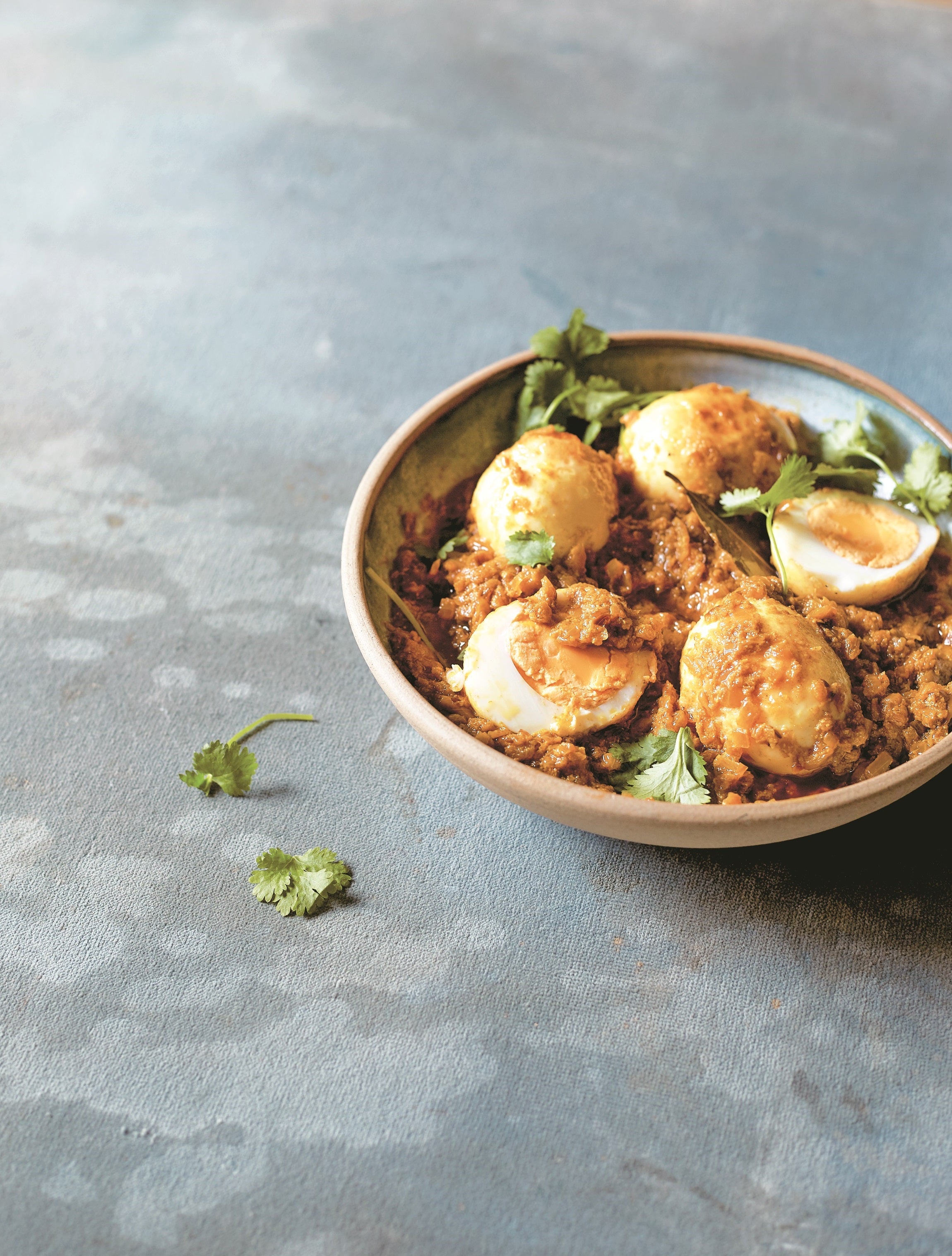
Serves 2, 210 kcal per person
Total cost at Tesco: £13.39, £6.70 per head
I associate egg curry with monsoons in Calcutta when the bazaar was closed due to flooding. The local delivery man would bring eggs to our home, cycling through the flooded streets. During Ramadan, eggs are a great source of nourishment and are quick to cook. You can boil the eggs in advance and put the dish together when you are ready to eat.
Ingredients
4 medium eggs
6tbsp vegetable oil
1 cardamom pod
1 clove
1 bay leaf
½tsp cumin seeds
2 medium onions
1tsp garlic paste
1tbsp fresh ginger paste
½tsp ground turmeric
1tbsp ground coriander
½tsp chilli powder
6tbsp natural (plain) yoghurt
1tsp salt
A handful of fresh herbs, to garnish
Method
If you keep your eggs in the refrigerator, take them out 30 minutes before cooking to bring them to room temperature. Fill a large pan with water and bring to a rolling boil over a high heat. Lower the heat to a simmer, then place the eggs in the water and cook for 12 minutes. Using a slotted spoon, remove the eggs from the pan and place in cold running water to prevent further cooking. When cool enough to handle, shell the eggs.
In a shallow saucepan, heat the oil over a medium–high heat. Add the hard-boiled eggs and cook until they are speckled all over with brown patches. Remove the eggs from the pan and set aside.
To the remaining oil, add the cardamom, clove, and bay leaf. Add the cumin seeds and cook, stirring, for a few seconds until the seeds darken.
Add the chopped onions, garlic, and ginger to the pan, cook for a further 5 minutes until the onion mixture has softened and coloured to a light brown. Continue to stir while cooking to prevent the onions from burning and sticking to the base of the pan. If the onion mixture does stick to the base of the pan, sprinkle over some water.
Add the ground turmeric, coriander, and chilli powder. Cook, stirring continuously, for 10–20 seconds or until the ‘raw’ smell of the turmeric has disappeared. Take care not to let the ground spices burn. Pour over 200 ml/7 fl oz/¾ cup plus 1 tbsp cold water and increase the heat to high.
Once any excess water has evaporated, lower the heat.
To avoid any lumps in the sauce, stir the yoghurt before adding it to the pan. Stir to mix evenly and then season with salt. Lastly, add the hardboiled eggs to the pan and allow to heat through before serving.
Before serving, scatter over plenty of fresh herbs.
Keema sau pulao
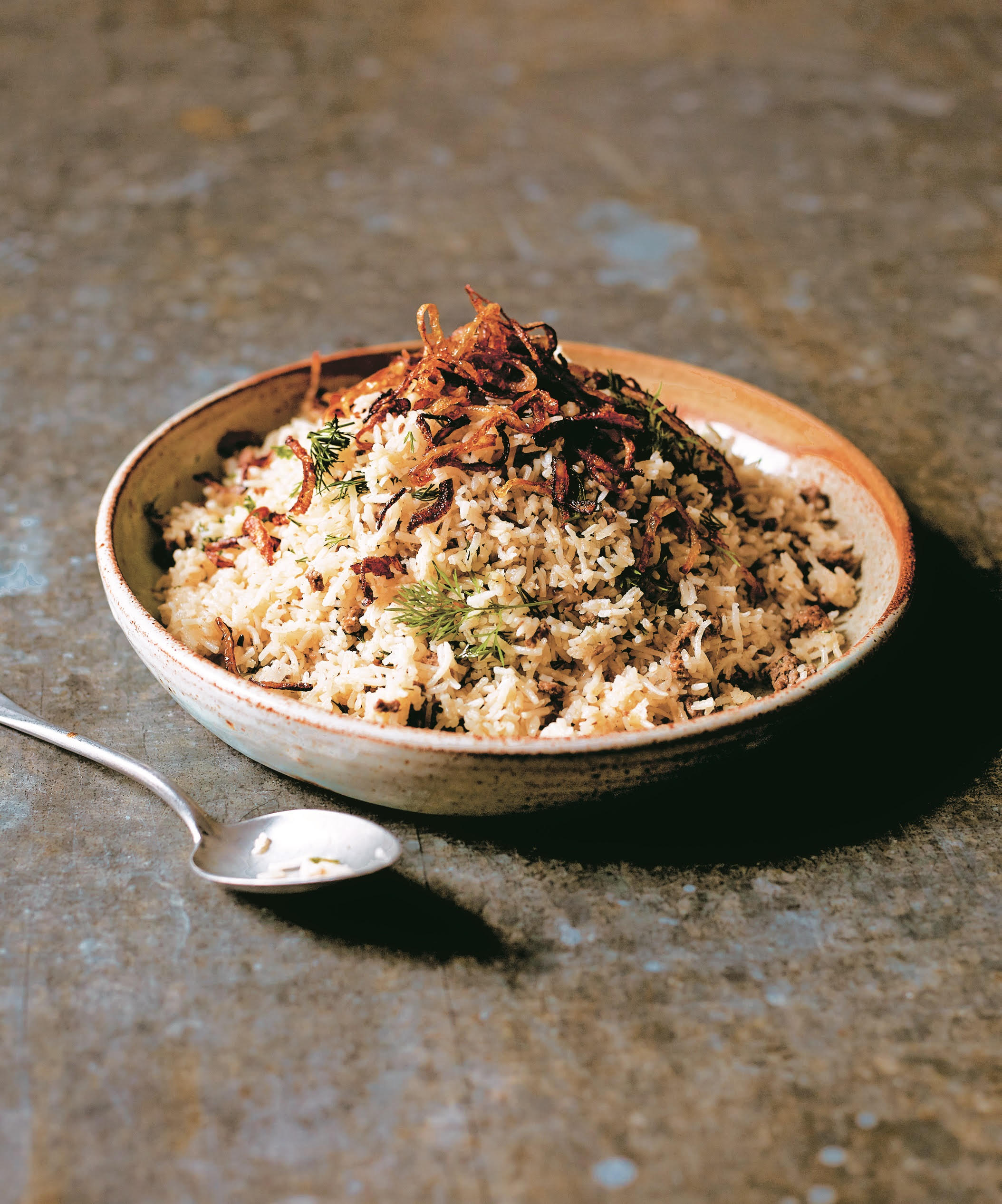
Serves 2, 460 kcal per person
Total cost at Tesco: £12.85, £6.43 per head
This dish can be made using any kind of mince – beef, lamb, chicken, and even soy. Minced meat cooks quickly so this is a great dish to prepare when you are short of time. The rice can be made in advance, then reheated in a low oven without any fear of the meat disintegrating. If you want to make just the keema you can add potatoes, peas or both to the keema. Towards the final stages you could add a couple of green chillies broken up into pieces. If you decide to make the pulao, the addition of dill is optional if you do not have it.
Ingredients
For the keema:
2tbsp oil
2 cardamom pods
1 cinnamon stick, 1cm long
2 bay leaves
25g onions, finely chopped
¼tbsp garlic paste
½tbsp fresh ginger paste
500g minced meat (beef, lamb, chicken) or soy
½tsp chilli powder
For the dill pulao:
300g basmati rice
3tbsp vegetable oil
2 cardamom pod
2 whole cloves
1 cinnamon stick, 1cm long
1 bay leaf
1 small-medium onion, sliced into thin rings
1 small bunch dill, leaves stripped and chopped
Method
Wash the rice in several changes of cold running water until the water runs clear, then place in a bowl and soak for 30 minutes in fresh water.
To make the keema, in a non-stick pan, heat 2 tbsp oil over a medium–high heat. Add the cardamom pods, cinnamon stick, and bay leaves to the pan. Immediately add the onions and cook for 1 minute, stirring. Add the garlic and ginger pastes and cook for a further 1 minute.
Add the mince to the pan, breaking up any clumps with the back of a spoon. Add salt to taste. If using chilli powder, add this to the mince.
Cook uncovered until all the liquid has evaporated from the mince.
Avoid adding any water, but if the mince sticks to the base of the pan, add a splash of water. Once cooked, remove from the heat, and set aside.
To make the pulao, in a heavy-based pan that has a lid, heat the oil over a medium–high heat. Add the onion rings and fry until caramelized.
Using a slotted spoon, remove the onions and place on a plate to drain. Spread the onions across the plate so they crisp as they cool.
Add the cardamom pods, cloves, cinnamon stick, and bay leaf to the pan. After a few seconds, remove from the pan with a slotted spoon and set aside.
Put the kettle on to boil. Add the rice to the pan and stir for 1 minute to coat in the spice-infused oil. Cover with 600 ml/1 pint/2½ cups boiling water from the kettle. Add ½ tsp salt and the cooked mince to the pan.
Cook uncovered over a medium–high heat until the water has been absorbed by the rice (about 4 minutes). Cover with the lid, lower the heat and simmer for a further 15–20 minutes. Once cooked, remove the pan from the heat and, using a fork, gently mix the rice and add the dill.
Cover and leave for a few minutes before serving with the onions.
Zafran murgh korma
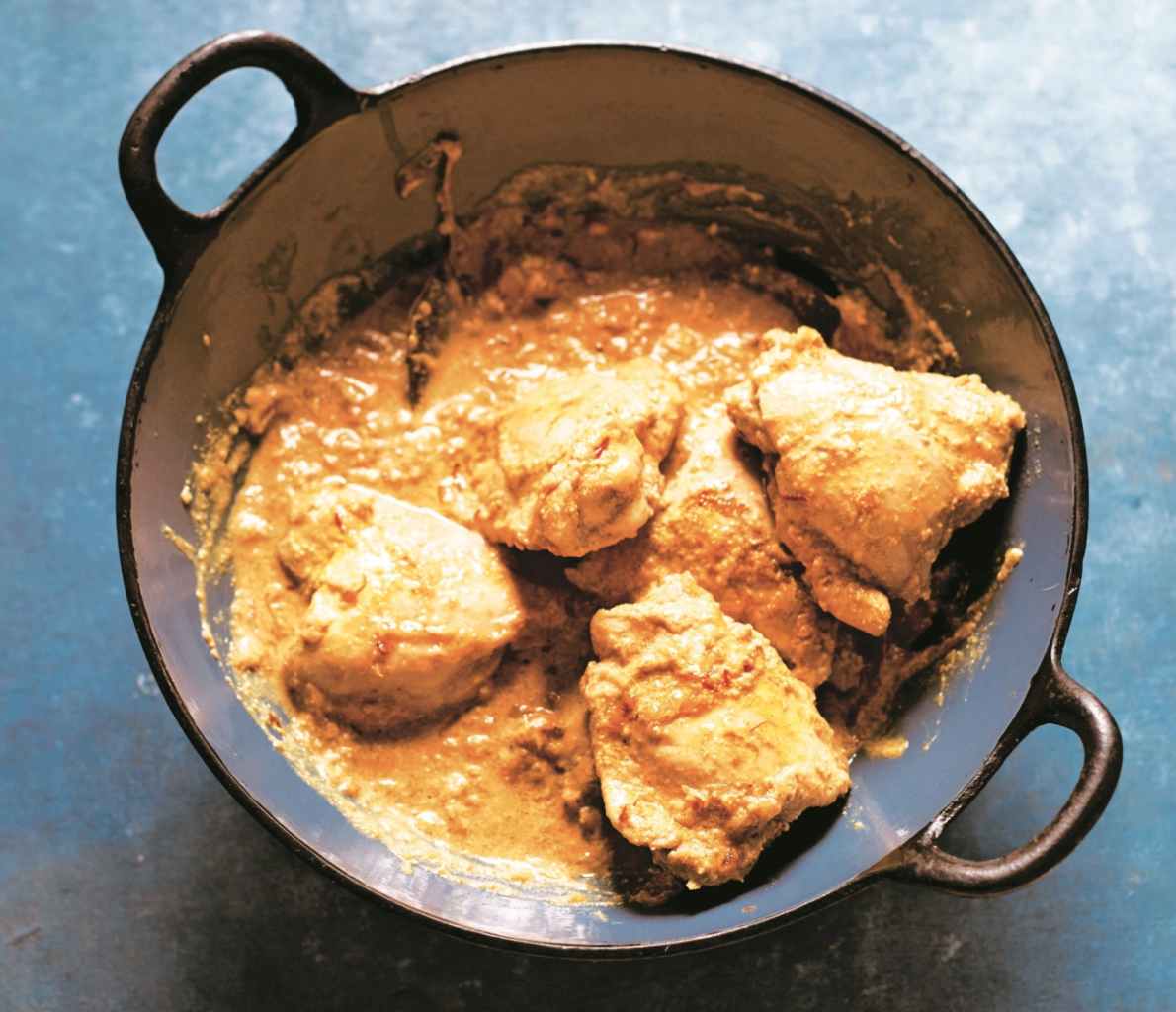
Serves 4 as a main course or 8 a part of a multi-course meal, 602 kcal per person
Total cost at Tesco: £21.80, £5.45 per head
An indulgent way to break a fast. This korma infused with saffron is a celebratory dish. One of the important traditions of Ramadan is sharing food with friends and family. As this cannot be done indoors, one way to keep the Ramadan tradition going is to make the saffron korma and deliver to friends and family or to eat it outside.
Ingredients
500g Turkish or Greek yoghurt (10 per cent fat)
1tbsp garlic paste
2tbsp fresh ginger paste
8 medium skinless chicken things (on the bone) (approximately 1kg)
2tbsp whole milk
Large pinch of good quality saffron strands
6tbsp vegetable oil
3 medium onions, evenly and thinly sliced into rings
1tsp powdered garam masala
1tbsp ground coriander
¼tsp chilli powder
1tsp salt
2tbsp ground almonds
1tbsp sugar
Small handful almond flakes, to garnish
Method
In a small bowl, combine the yoghurt with the garlic and ginger pastes.
Place the chicken thighs in a non-reactive container with a lid and spoon over the marinade, making sure that every surface of the chicken is covered. Cover the container and place in the refrigerator for 30 minutes.
Gently warm the milk in a pan. Do not boil the milk; it should only be tepid as you do not want to scald the saffron. Touch the surface of the milk to check the temperature, then when the milk is tepid add the saffron strands and leave to infuse.
In a deep pan or wok that has a lid, heat the vegetable oil over a medium– high heat. Add the onions to the pan and fry gently, stirring occasionally, until golden brown and caramelized. Using a slotted spoon, remove the onions from the pan, leaving as much of the oil in the pan as possible to cook the other ingredients, and place on a plate to drain.
Spread the onion rings across the plate so they crisp as they cool.
Add the whole garam masala to the same pan and oil used to fry the onions. After a few seconds, add the ground coriander and continue to cook, stirring. After 1 minute, add the marinated chicken to the pan along with the marinade from the container. Keeping the heat on medium–high, continue stirring gently. After 5 minutes, or when the oil separates from the yoghurt and comes to the surface, add the chilli powder and salt. Lower the heat, cover the pan with the lid and simmer gently for 35 minutes. The chicken is ready when the edges have softened and are slightly curled.
Remove the pan from the heat. Add the saffron-infused milk, ground almonds and sugar. Stir the softened chicken gently to avoid breaking it up.
Before serving, taste to check the seasoning and adjust as necessary.
Garnish with the flaked almonds and the fried onions.
* * *
Here’s Khan’s top picks for easy to follow, filling Ramadan recipes from the Tesco Real Food website.
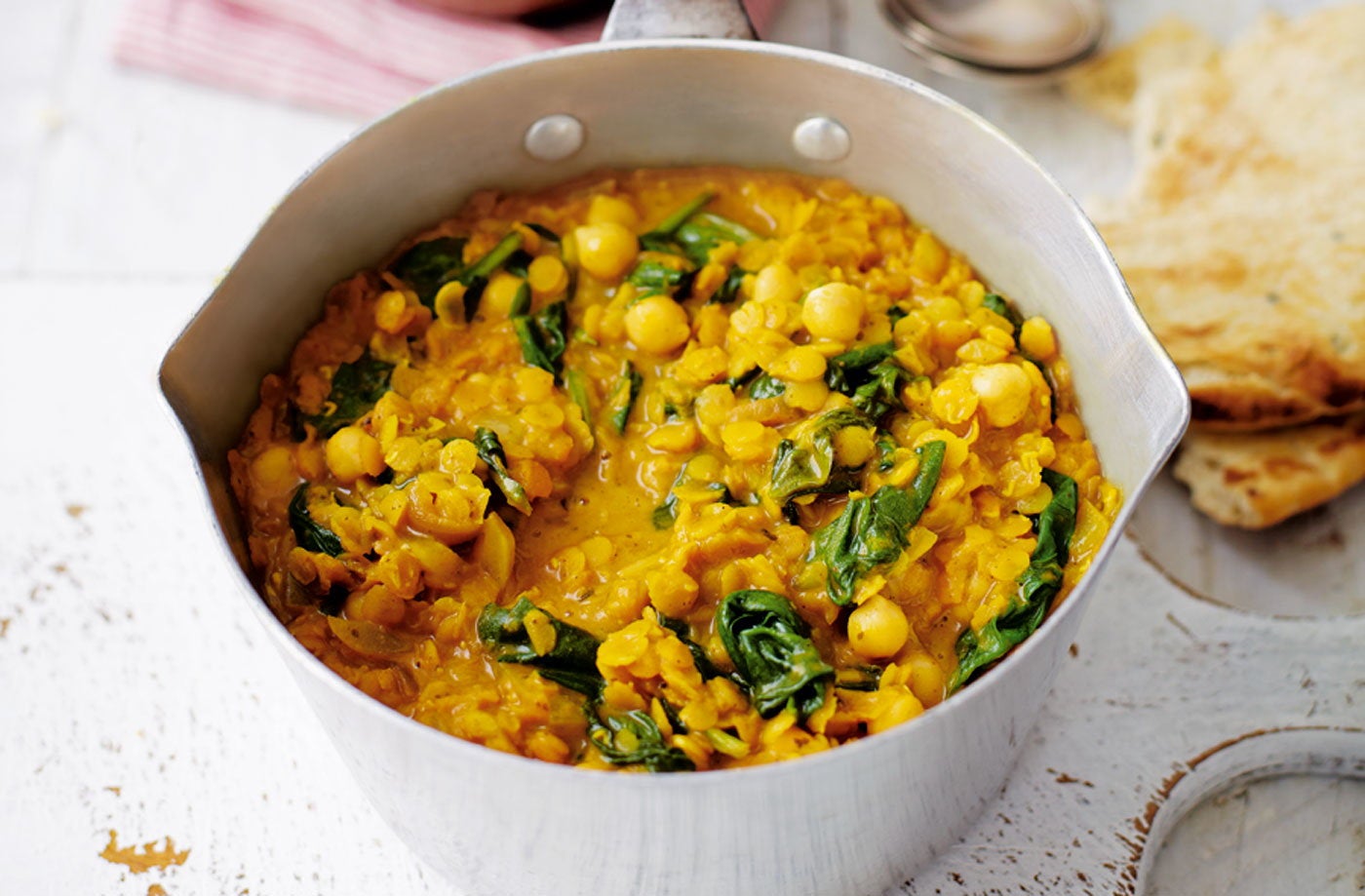
Make this wholesome and hearty dhal dish made with coconut milk, chickpeas and red lentils - the perfect dish to keep away the chill.
Serves 4, 627 kcal per person
Total time: 10 mins to prepare, 35 mins to cook
Ingredients
250g red lentils
1tbsp vegetable oil
1 onion, chopped
1 garlic clove, crushed
45ml (3tbsp) tikka curry paste
400g tin chickpeas, drained and rinsed
400g tin reduced fat coconut milk
200g spinach
1 lemon, juiced
To serve:
2 packs plain naan
Method
1. Rinse and drain the lentils.
2. Heat the oil in a large pan and fry the onion and garlic for a minute over a high heat. Stir in 3 tbsp curry paste and sizzle for another minute, then add the rinsed lentils and 1 tin chickpeas.
3. Pour in the coconut milk, then fill the tin with water and add that, too.
4. Bring to the boil and cook for about 30 minutes until the lentils are just done.
5. Stir in the spinach to wilt, season and add the lemon juice. Serve with plain naan.
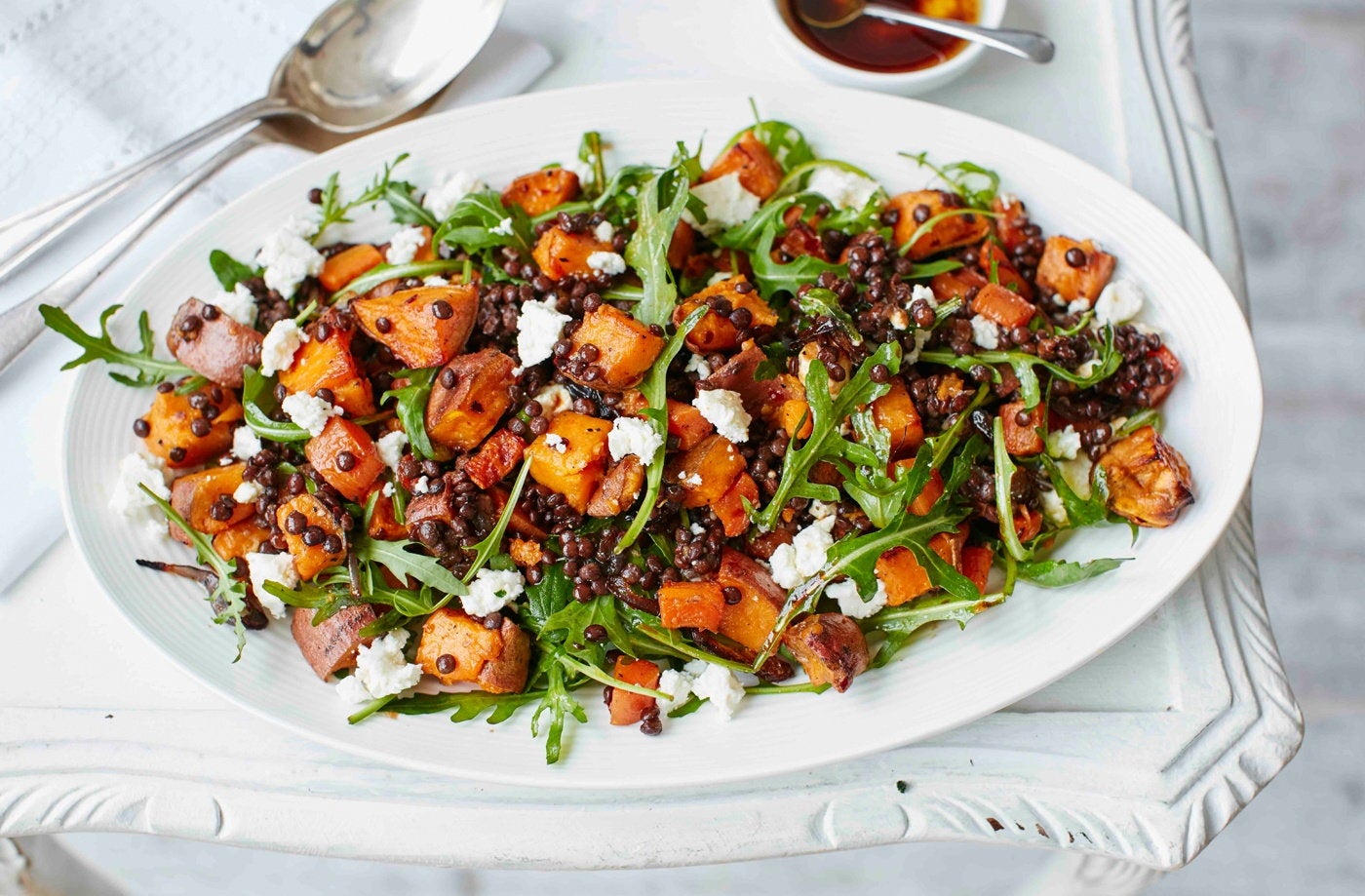
This hearty salad is packed with roasted sweet potatoes, carrots and red onion, which pair wonderfully with puy lentils and crumbled feta. Try this easy recipe for a healthy dinner or leisurely weekend lunch.
Serves 4, 348 kcl per person
Total time: 20 mins to prepare, 30 mins to cook
Ingredients
2 large carrots, cut into cubes
1 red onion, finely sliced
2 medium sized sweet potatoes, cut into cubes
3tbsp olive oil
Pinch dried chilli flakes (optional)
2tbsp balsamic vinegar or pomegranate molasses
250g pack cooked puy lentils
75g feta, crumbled
50g rocket
Method
1. Preheat the oven to gas 7, 220C, fan 200C. Put the carrot, onion and sweet potato in a large shallow baking tray, drizzle with 2 tbsp olive oil and the chilli flakes, if using, season well and roast for 30 mins, turning occasionally, or until tender and turning golden.
2. Heat the lentils according to the pack instructions, and then scatter over a serving platter. Top with the roasted vegetables, crumbled feta and rocket then drizzle with the balsamic vinegar or pomegranate molasses and the rest of the extra-virgin olive oil.
Recipes from Asma’s Indian Kitchen, published by Pavilion, 2018. For more mealtime inspiration during Ramadan and beyond, Tesco Real Food has easy to follow recipes.







